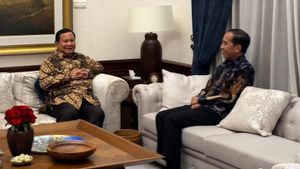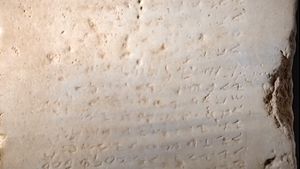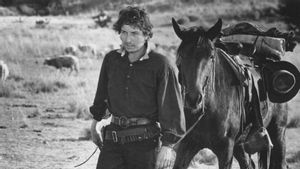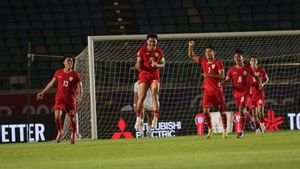JAKARTA The Barongsai has always been a typical show in every Chinese New Year celebration. At first, the show paraded the lion's head mask as a special ritual in every celebration of the Confucian day as a symbol of happiness, prosperity and luck.
However, now its function is getting wider, lion dance is also an entertainment event for the community and has been recognized as a sport in the world, including in Indonesia.
The barongsai arts entering Indonesia are estimated in the 17th century, along with the large migration of the Chinese people, especially in the southern part. Those who settled later also popularized their culture.
The lion dance show, according to Nanik Suratmi in the book 'Multicultural: Work on the Preservation of the Barongsai-Lion Arts Loka', became increasingly popular when the Chinese organization Hwee Kwan appeared or the Chinese Association House in 1901. Not only did he wear a lion head mask called Sam sie, the show also performed a dragon dance called Liong.
According to ancient Chinese philosophy, said Nanik, the lion dance accompanied by Liong will be a combination of positive and negative. This illustrates the world's condition that always consists of two elements.
Even so, the usual performances are still limited to rituals. The lion dance and its players had to undergo a thiamtiam ceremony before the show. This is a lion dance ceremony performed in the temple or in lithang, a place of worship for the Confucian people. The goal is to expel evil spirits so that performances can take place safely.
All lion dance players and administrators are required to follow the procession. Even though the process is carried out by temples or litang, those who adhere to different religions are advised to pray according to their respective beliefs," he wrote.
Thiam's ceremony between Buddhist and Confucian beliefs is slightly different. In Buddhist belief, the ceremony begins with the laying of a lion dance that will be worn on a special rig with eyes and mouth covered with red cloth. Then, the leader of the ceremony performs prayers to thebuka.
The lion dance body is sprinkled with levy water, the blood of the white rooster is dripped on the head as a means of force to repel evil spirits when paraded. Then, the red cloth covering the eye and the mouth of the lion dance is removed. The lion dance eyes are marked with red paint, including in the ears, nose, and mouth.
"On the lion dance horn, red cloth and orange leaves are also tied," said Nanik.
Meanwhile, in the Confucian tradition, after a prayer is performed by the ceremonial leader, the lion dance head will be sprinkled with prayer ash three times. This is believed to bring safety and luck.
The lion dance eye will be written in the mandin letter with a red marker which is believed to be the denoter of reinforcements. This article is like a person giving a name. Then, the lion dance horn will be tied with ale of orange leaves which are believed to bring coolness to humans.
After the ceremony, the lion dance performance started. The lion dance is paraded around according to the predetermined route.
After the show, it continued to the lion dance burning procession with the intention of repatriating the spirit that had entered during the game or procession. However, according to Nanik, this procession is almost no longer carried out considering the price of expensive lion dance costumes.
Since President Abdurrahman Wahid (Gus Dur) revoked Presidential Instruction No. 14 of 1967 concerning Chinese religion, belief, and customs, the function of lion dance has grown widely into a means of public entertainment.
Barongsai performances are starting to get popular, not only in Chinese New Year's moments, lion dances are also often a show for birthdays, weddings, business openings, political party events, and others.
In fact, since 2013, lion dance has officially become a sport in Indonesia. At the 2016 National Sports Week (PON) which took place in West Java, lion dance was included in the exhibition sport along with 11 other sports which were approved by the Indonesian National Sports Committee (KONI). There were 712 athletes from 15 provinces who participated.
"Of course it is different from ritual events, in the function of performances for entertainment, lion dances are not mandatory to be smeared," said Nanik.
Likewise in sports. Aleng Herman, chairman of the Prosperous Barongsai Group (GBS) Pontianak said there was no need for rituals, "The important thing is to practice regularly when participating in championships."
Sam Sie has a head circumference of 135-140 cm with a height of 60 cm and a length from head to tail of about 2 meters played by two people. While Liong, who ideally has a body length of 19-20 meters from head to tail, needs at least 9 people to play it.
Therefore, a player or lion dance athlete must have special skills with a strong enough physique to lift Sam Sie and Liong so that one player with another looks balanced and harmonious. Being able to display acrobatic movements such as lion or dragon movements.
The lion dance has no specific reference. It only describes a sleeping lion, a lion is in a state of pleasure, a lion is looking for food and other movements that describe animal activity. So, for a kind of movement depending on the creativity of each player," Nanik wrote.
Aleng also admitted that playing lion dance requires special technique. Physical exercise and basic training are needed for horses.
One team is playing on the head and tail. The head player must be agile jumping here and there, the tail player must be strong to support him. Then also need an expert who can play music as an accompaniment," he told VOI, Friday (20/1).
A lion dance player must train regularly. On GBS, training can be 4 times a week with a duration of 3-4 hours per exercise.
If there are certain events, such as championships or training shows, they can be done every day. This is to train cohesiveness, design certain movements so that the lion dance performance can be more attractive, not just jumping around," he added.
The English, Chinese, Japanese, Arabic, and French versions are automatically generated by the AI. So there may still be inaccuracies in translating, please always see Indonesian as our main language. (system supported by DigitalSiber.id)













